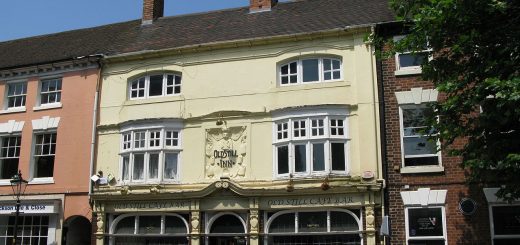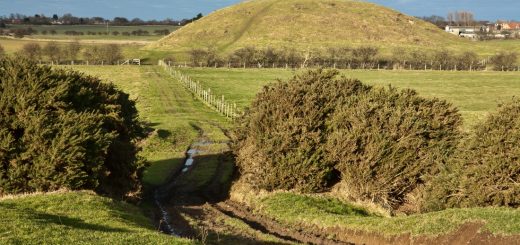Unknown Mansion and Queensberry House, Canongate
In ‘The Haunted Homes and Family Traditions of Great Britain’ (1897), John Ingram gives the following account of a haunting associated with Canongate in Edinburgh. Named after the Augustine canons of Holyrood Abbey, Canongate can be found at the lower eastern part of the Royal Mile in Edinburgh and the mansion referred to is according Ingram no longer standing.
‘About the beginning of the eighteenth century stood a grand mansion near the head of the Canongate, the site of which now, however, is covered with buildings of a very different character. With this old mansion is connected a tale of terror, the circumstances of which were well known and talked about no longer ago than the beginning of the present century. A friend of Sir Walter Scott, in whose early life the story was still current, furnished him with the account from which the following version of the tradition is derived.
At the period referred to, a divine of great sanctity was summoned in the middle of a certain night, to come and pray with a person at the point of death. This was no unusual summons, but the consequences which followed were very terrifying. He was forced into a sedan chair, and, after having been carried for a considerable distance, was set down in a remote part of the city, where, at the muzzle of a cocked pistol, he was compelled to submit to being blindfolded. In the course of the discussion which his re-monstrances caused, he heard enough, and, indeed, saw enough of their garb, to make him conjecture that the chairmen were greatly above the menial position they had assumed.
After many turnings and windings the sedan was carried up-stairs into an apartment, where the bandage was removed from his eyes, and whence he was conducted into a bed-chamber, where he found a lady recently delivered of an infant. He was commanded by one of those who had brought him to this place to say such prayers by the lady’s bed-side as were suitable for a person not expected to survive a mortal disorder. The divine ventured to remonstrate, observing that the lady’s appearance warranted a more hopeful condition. He was sternly commanded to obey his instructions, and so, but with much difficulty, recollected himself sufficiently to acquit himself of the duty enjoined him.
As soon as his ministrations were deemed performed, the divine was again blindfolded; replaced in the chair, and hurried off, but, as he was being carried down-stairs, he heard the ominous report of a fire-arm. He was taken home safely, and a purse of gold forced upon him; but, at the same time, he was warned that the least allusion to the affair which had just transpired would cost him his life. He betook himself to his bed- chamber, but was speedily aroused by his servant with the information that a most furious fire had just broken out in the house of … , near the head of the Canongate, and that the proprietor’s daughter, a lady eminent for her beauty and accomplishments, had perished in the flames.
Our divine had his suspicions, but to have made them public would have availed nothing but to jeopardise his own safety. He was timid, and the family was one of power and distinction, so he soothed himself with the reflection that the deed was done and could not be undone. Time passed on, and with it carried away some of his fears. He became unhappy at being the sole custodian of so dark a secret, and, therefore, gradually told it to some of his brother clergy, so that by degrees the whole story leaked out.
In due course the divine died, and his terrible tale had become nearly forgotten, when it so happened that a fire broke out again on the very same site where the house of . . . had formerly stood, but where now stood buildings of an inferior style. When the flames were at their height, the tumult which usually attends such a scene, was suddenly suspended by a marvellous apparition. A beautiful female, in an extremely rich, but very antique style of night-dress, appeared in the very midst of the fire, and in an awful voice uttered these terrifying words: “Once burned! twice burned! the third time I will scare you all ! “
![Kim Traynor [CC BY-SA 3.0 (https://creativecommons.org/licenses/by-sa/3.0)], from Wikimedia Commons](http://www.mysteriousbritain.co.uk/wp/wp-content/uploads/2018/12/1280px-Queensberry_House_Canongate_Edinburgh-300x225.jpg) “The belief in this story,” says our authority, “was formerly so strong, that on a fire breaking out, and seeming to approach the fatal spot, there was a good deal of anxiety testified lest the apparition should make good her denunciation.”
“The belief in this story,” says our authority, “was formerly so strong, that on a fire breaking out, and seeming to approach the fatal spot, there was a good deal of anxiety testified lest the apparition should make good her denunciation.”
The Paranormal Database suggest the building in question was Queensberry House. However I am not sure this is right. Queensberry House is now incorporated into the new Scottish Parliament building and has another haunting story attached to it. Queensberry House dates from 1681 and from 1686 was the home of the politician William Douglas, 1st Duke of Queensberry (Born 1637 – Died 1695). The mentally ill James Douglas, Earl of Drumlanrig (Born 1697 – Died 1715) was at Queensberry House when his father, James Douglas the ‘Union’ Duke of Queensberry signed the Union with England Act (1707). Whilst the household was out celebrating this unique political event, James escaped from his room and headed to the kitchen looking for food. Some time later when the servants arrived back they found that James had skewered the kitchen boy on a spit, roasted him alive in the kitchen fireplace and had eaten some of the dead child. The ‘Union’ Dukes opponents saw this as his punishment for the Act of Union. The oven is now in the Scottish Parliament’s Allowances Office. It has been suggested that the ghost of the kitchen boy haunts Queensberry House, but I do not know of any actual experiences to support this idea yet.




Re: Unknown Mansion and Queensberry House, Canongate
DANGEROUS GHOSTS (1954) Elliott O’Donnell
The town mansion of the Duke* in Canongate, a large, gloomy mansion, was likewise rumoured to be haunted. After standing empty for many years it was converted into a home for destitute people. No one seems to have enquired or cared whether the ghost frightened them.
*Duke of Queensberry